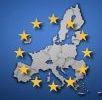Europe is in the air ash blockade
Europe is in the air blockade. From different points of the globe, 10 million people cannot fly here. This will cost carriers no less than a billion dollars. The Europeans were scared by a statement by the World Health Organization that volcanic dust could be hazardous to health.
11 thousand canceled flights is a completely unexpected, although quite natural blow from the side of nature. If you think about it, then nothing unusual happened; not the most powerful volcano woke up. But this event turned out to be no less terrible than any disaster caused by man himself.
“If you fly a plane worth several million pounds into a cloud of volcanic dust, there is no doubt that you will not be able to get out of it safe and sound,” states Eric Moody, a former British Airways pilot. “That’s why airlines insist on a flight ban “But if you want to tickle your nerves, the best way is to direct the plane into the cloud, lose the thrust of all four engines and begin to fall, and around – the night. Then you will understand what we experienced in our time.”
In 1982, he managed a Boeing of British Airways, which fell into a cloud of volcanic ash. The crew and passengers then saved just a miracle.
“We had all the windows in the cockpit damaged. Nothing was visible through them. Landing lights were broken, even the paint was peeling off. And then all four engines stopped, the autopilot turned off. And we began to fall from a height of 37 thousand feet. Then it turned out that the ash got into the combustion chambers, “says the former pilot.
His words, it would seem, should cool hotheads, but they do not provide an answer to the following question: what to do when air traffic over Europe is actually paralyzed?
Airports are more and more like dugouts for the homeless, and airline managers are helpless. Europe this year with the vagaries of nature is clearly not lucky. If in winter the infrastructure was literally frozen, now the ill-fated volcano has woken up. And the result is the same!
From London to get to the continent in the coming days is almost impossible. In a matter of hours, all train tickets were sold out and now it’s easier to wait for the volcanic clouds to disperse. And where to strive? On the continent, things are not much better.
Here’s what people in France say:
– We managed to get on the train from Milan to Paris, but now what to do? I’ll try to buy a train ticket to London.
– To be honest, I don’t like that at all. First, a long flight from Los Angeles, now also this. I just want to go home to my parents, I really don’t like the prospect of being stuck here for 3-4 days.
It got to the point that one rental company in Frankfurt is now forming motor convoys, which, like medieval caravans, should go to the north of Europe.
“There aren’t enough cars for everyone. We are trying to form groups of our customers traveling to Scandinavia. People don’t know each other, but they will have to travel shoulder to shoulder one, or even two thousand kilometers, if they want to reach their destination,” says Stefanie Auer, a spokesman for the German car rental network.
But the main thing is that the forecasts are not too encouraging yet. And there are scary warnings. For example, the World Health Organization advises not to go outside if necessary, especially in the rain. As a result, the frightened Europe is now peering anxiously into the gloomy clouds. True, gaps also happen. For example, in Norway and Ireland, an air corridor was temporarily opened on Friday. But in London Heathrow, so far, work is only for journalists. The picture is pretty monotonous. The lifeless runway and the silence unusual for this busy place. Airspace over the UK will be closed before midnight.
Dust cloud of Icelandic volcano enveloped all of Europe and moves to the Urals
Finnish F-16 fighters during a planned exercise fell into a volcanic cloud and received serious damage. A crystalline crust was found on the engine parts, which, according to mechanics, could lead to the complete destruction of the turbines. German airports cannot accept Angela Merkel’s aircraft. The Chancellor, who returns home from Washington, will have to spend the night in Portugal. And the king of Norway, on the contrary, cannot fly from Oslo to Denmark for the Queen’s birthday. In Russia, a volcanic cloud has covered the Kola Peninsula and is moving towards St. Petersburg. More than a hundred flights have already been canceled in Moscow.
Air carriers no longer have time to warn their passengers about cancellations, and many will find out this unpleasant news upon arrival at the airport.
“They have been waiting for this trip for a long time. Friends are waiting for us in Italy. I have a birthday that we were going to celebrate together. I’ve covered the whole cloud,” states Valentina Fedorova, who is waiting for her flight to Italy in Pulkovo.
Among the passengers who have not flown away, especially those traveling in transit, complaints are already heard – some airlines refuse to feed them. Although, as you know, this is a prerequisite for long delays.
A cloud of ash is completely invisible from the earth and almost invisible from space. Only with the help of spectral analysis and constant sounding of the atmosphere did scientists find out that the cloud is already over Russia. And in the upper atmosphere, at an altitude of nine to ten kilometers, has advanced quite far.
“The very front front, which spreads in the high atmospheric layers, is located much east of Moscow, moves to the Urals. The front of ash clouds goes to the region of the Komi Republic, the Nenets okrug, the polar Urals and even goes to the Arctic,” explains Phobos weather center lead specialist “Leonid Starkov.
When the main array of clouds reaches us, scientists cannot say. But while in the sky over Russia the situation is not so critical.
“Those concentrations that are today over the Russian Federation, over its European part, are still not those that allow you to suspend traffic. At the same time, this night crews of individual Russian aircraft noted glare overboard, which indicates that there are certain small concentrations of this ash, “says Valery Dyadyuchenko, deputy head of Roshydromet.
Aircraft have not yet learned how to protect themselves from volcanic ash. And in high concentrations, it poses a serious danger.
“Often this is glass, often augite crystals. Now if you take granite stone, crush it, then by consistency it will be what is now flying in the air,” says a leading researcher at the Institute of Volcanology and Seismology of the Far Eastern Branch of the Russian Academy of Sciences Alexey Ozerov.
And in a dense cloud, radio communications and visibility are getting worse. On an aircraft that flies at a speed of more than eight hundred kilometers per hour, even the smallest particles of dust act like emery. And they can damage the windshield. But this is not the worst.
“The main danger is that the engine may fail. Clogged holes in the engine, which are used to supply air to various parts of the engine, somewhere to mix with fuel, somewhere to cool. And these holes are very small in diameter. They can clogged with ash, “- says Valery Sukhanov, deputy director of the Central Aerodynamic Institute named after N. Ye. Zhukovsky Valery Sukhanov.
Or, for example, in the hot chamber of an aircraft engine, small particles of ash can sinter and form such a glassy shirt on the blades. Which, of course, affects the operation of engines, up to their failure.
The Russian Ministry of Emergency Situations is ready to deploy a headquarters for monitoring the situation in the sky.
“An interdepartmental task force has been created and is working in the Russian Emergencies Ministry. It included representatives of the Russian Academy of Sciences, Roshydromet, the Federal Air Transport Agency, the Ministry of Nature, the Ministry of Transport and other ministries and departments of the Russian Federation,” reported Irina Andrianova, head of the Russian Emergencies Ministry’s information department.
Meteorologists and volcanologists warn, even if the eruption stops in the next day, the Icelandic plume can circumnavigate the globe several times and circle over the northern latitudes, making its own adjustments to the flight schedule. Until it rains on the ground.
This post is also available in:
 English
English  Русский (Russian)
Русский (Russian)






